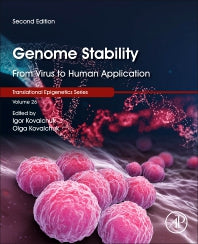Freshly Printed - allow 10 days lead
Couldn't load pickup availability
Genome Stability
From Virus to Human Application
Provides a deep, integrated exploration of genome stability and instability across species and disease types, enabling new research and advancing precision medicine
Igor Kovalchuk (Edited by), Olga Kovalchuk (Edited by)
9780323856799, Elsevier Science
Paperback / softback, published 22 July 2021
760 pages, 300 illustrations (200 in full color)
27.6 x 21.5 x 4.6 cm, 2.04 kg
Genome Stability: From Virus to Human Application, Second Edition, a volume in the Translational Epigenetics series, explores how various species maintain genome stability and genome diversification in response to environmental factors. Here, across thirty-eight chapters, leading researchers provide a deep analysis of genome stability in DNA/RNA viruses, prokaryotes, single cell eukaryotes, lower multicellular eukaryotes, and mammals, examining how epigenetic factors contribute to genome stability and how these species pass memories of encounters to progeny. Topics also include major DNA repair mechanisms, the role of chromatin in genome stability, human diseases associated with genome instability, and genome stability in response to aging. This second edition has been fully revised to address evolving research trends, including CRISPRs/Cas9 genome editing; conventional versus transgenic genome instability; breeding and genetic diseases associated with abnormal DNA repair; RNA and extrachromosomal DNA; cloning, stem cells, and embryo development; programmed genome instability; and conserved and divergent features of repair. This volume is an essential resource for geneticists, epigeneticists, and molecular biologists who are looking to gain a deeper understanding of this rapidly expanding field, and can also be of great use to advanced students who are looking to gain additional expertise in genome stability.
1. Genome stability: An evolutionary perspective Part I Genome instability of viruses 2. Genetic instability of RNA viruses 3. Genome instability in DNA viruses Part II Genome instability in bacteria and archaea 4. Genome instability in bacteria and archaea: Strategies for maintaining genome stability 5. Genome instability in bacteria: Causes and consequences 6. CRISPR – Bacterial immune system Part III Genome stability of unicellular eukaryotes 7. From micronucleus to macronucleus: Programmed DNA rearrangement in ciliates is regulated by non-coding RNA molecules 8. Homologous recombination and nonhomologous end-joining repair in yeast Part IV Genome stability in multicellular eukaryotes 9. Meiotic and mitotic recombination: First in flies 10. Genome stability in Drosophila: Mismatch repair and genome stability 11. Genome stability in Caenorhabditis elegans 12. Plant genome stability—General mechanisms 13. Genetic engineering in plants using CRISPRs Part V Genome stability in mammals 14. Cell cycle control and DNA-damage signaling in mammals 15. The role of p53/p21/p16 in DNA damage signaling and DNA repair 16. Roles of RAD18 in DNA replication and post-replication repair (PRR) 17. Base excision repair and nucleotide excision repair 18. DNA mismatch repair in mammals 19. Repair of double-strand breaks by nonhomologous end joining; Its components and their function 20. Homologous recombination in mammalian cells: From molecular mechanisms to pathology 21. Telomere maintenance and genome stability 22. Chromatin, nuclear organization and genome stability in mammals 23. Role of DNA mthylation in genome stability 24. Non-coding RNAs in genome integrity Part VI Human diseases associated with genome instability 25. Human diseases associated with genome instability 26. Cancer and genomic instability 27. Epigenetic regulation of the cell cycle & DNA-repair in cancer 28. Genomic instability and aging: Causes and consequences 29. The DNA damage response and neurodegeneration: Highlighting the role of the nucleolus in genome (in)stability Part VII Effect of environment on genome stability 30. Diet and nutrition 31. Chemical carcinogens and their effect on genome and epigenome stability 32. Modern sources of environmental ionizing radiation exposure and associated health consequences Part VIII Bystander and transgenerational effects: Epigenetic perspective 33. Sins of fathers through a scientific lens: Transgenerational effects 34. Radiation and chemical induced genomic instability as a driver for environmental evolution 35. Transgenerational genome instability in plants 36. Methods for the detection of DNA damage 37. Conserved and divergent features of DNA repair. Future perspectives in genome stability research 38. Off-target effects in genome editing
Subject Areas: DNA & Genome [PSAK1], Genetics [non-medical PSAK]


